Citizen Science on Maritime Traffic: Implications for European Eel Conservation
Abstract
1. Introduction
2. Materials and Methods
2.1. Ethics Statement
2.2. Citizen Science Recruitment
2.3. Estuaries Studied
2.4. Maritime Traffic Records
2.5. Post-Activity Survey
- (1)
- Between 0 as extremely bad and 10 as extremely good, how do you evaluate this citizen science experience?
- (2)
- Could you please describe briefly what was the most interesting part of this project for you?
- (3)
- After this experience, would you participate in other citizen science projects? (yes/no)
2.6. Data Curation
2.7. Statistics
3. Results
3.1. Citizen Science Performance and Volunteer Satisfaction
3.2. Maritime Traffic Recorded in the Studied Estuaries
4. Discussion
5. Conclusions
Author Contributions
Funding
Institutional Review Board Statement
Informed Consent Statement
Data Availability Statement
Acknowledgments
Conflicts of Interest
References
- UNCTAD. Review of maritime transport 2023. In Towards a Green and Just Green and Just Transition Transition; United Nations Publications: New York, NY, USA, 2023; Available online: https://unctad.org/system/files/official-document/rmt2023_en.pdf (accessed on 29 October 2024).
- Sardain, A.; Sardain, E.; Leung, B. Global forecasts of shipping traffic and biological invasions to 2050. Nat. Sustain. 2019, 2, 274–282. [Google Scholar] [CrossRef]
- ICOMIA. International Council of Marine Industry Associations. Available online: https://www.icomia.org/ (accessed on 26 February 2025).
- Onyena, A.P.; Nwaogbe, O.R. Assessment of water quality and heavy metal contamination in ballast water: Implications for marine ecosystems and human health. Marit. Technol. Res. 2024, 6, 270227. [Google Scholar] [CrossRef]
- Cakir, E.; Sevgili, C.; Fiskin, R. An analysis of severity of oil spill caused by vessel accidents. Transp. Res. D Trans. Environ. 2021, 90, 102662. [Google Scholar] [CrossRef]
- Ivanova, S.V.; Kessel, S.T.; Espinoza, M.; McLean, M.F.; O’Neill, C.; Landry, J.; Hussey, N.E.; Williams, R.; Vagle, S.; Fisk, A.T. Shipping alters the movement and behavior of Arctic cod (Boreogadus saida), a keystone fish in Arctic marine ecosystems. Ecol. Appl. 2020, 30, e02050. [Google Scholar] [CrossRef]
- Becker, A.; Whitfield, A.; Cowley, P.; Järnegren, J.; Næsje, T. Does boat traffic cause displacement of fish in estuaries? Mar. Pollut. Bull. 2013, 75, 168–173. [Google Scholar] [CrossRef]
- González Correa, J.M.; Bayle Sempere, J.-T.; Juanes, F.; Rountree, R.; Ruíz, J.F.; Ramis, J. Recreational boat traffic effects on fish assemblages: First evidence of detrimental consequences at regulated mooring zones in sensitive marine areas detected by passive acoustics. Ocean Coast. Manag. 2019, 168, 22–34. [Google Scholar] [CrossRef]
- Stanley, J.A.; Van Parijs, S.M.; Hatch, L.T. Underwater sound from vessel traffic reduces the effective communication range in Atlantic cod and haddock. Sci. Rep. 2017, 7, 14633. [Google Scholar] [CrossRef]
- Barry, J. The Foraging Specialisms, Movement and Migratory Behaviour of the European Eel. Ph.D. Thesis, University of Glasgow, Glasgow, Scotland, UK, 2015. [Google Scholar]
- Dekker, W. Management of the eel is slipping through our hands! Distribute control and orchestrate national protection. ICES J. Mar. Sci. 2016, 73, 2442–2452. [Google Scholar] [CrossRef]
- Pike, C.; Crook, V.; Gollock, M. Anguilla anguilla. The IUCN Red List of Threatened Species 2020. e.T60344A152845178. Available online: https://www.fishsec.org/app/uploads/2022/11/200709-Assessment-10.2305_IUCN.UK_.2020-2.RLTS_.T60344A152845178.en_.pdf (accessed on 19 August 2024).
- McDowall, R.M. Diadromy in Fishes: Migration Between Freshwater and Marine Environments; Timber Press: Portland, OR, USA, 1988; p. 308. [Google Scholar]
- Global Maritime Traffic. Available online: https://globalmaritimetraffic.org/ (accessed on 11 August 2024).
- Daverat, F.; Lanceleur, L.; Pécheyran, C.; Eon, M.; Dublon, J.; Pierre, M.; Schäfer, J.; Baudrimont, M.; Renault, S. Accumulation of Mn, Co, Zn, Rb, Cd, Sn, Ba, Sr, and Pb in the otoliths and tissues of eel (Anguilla anguilla) following long-term exposure in an estuarine environment. Sci. Total Environ. 2012, 437, 323–330. [Google Scholar] [CrossRef]
- Durif, C.; Dufour, S.; Elie, P. The silvering process of Anguilla anguilla: A new classification from the yellow resident to the silver migrating stage. J. Fish Biol. 2005, 66, 1025–1043. [Google Scholar] [CrossRef]
- Tesch, F.W. The Eel; Tesch, F.W., Thorpe, J.E., Eds.; Blackwell Science: Oxford, UK, 2003; pp. 1–408. [Google Scholar]
- Cresci, A. A comprehensive hypothesis on the migration of European glass eels (Anguilla anguilla). Biol. Rev. 2020, 95, 1273–1286. [Google Scholar] [CrossRef]
- Podda, C.; Palmas, F.; Pusceddu, A.; Sabatini, A. Hard times for catadromous fish: The case of the European eel Anguilla anguilla (L. 1758). Adv. Oceanog. Limnol. 2021, 12, 9997. [Google Scholar] [CrossRef]
- ICES 2023. European eel (Anguilla anguilla) throughout its natural range. In Report of the ICES Advisory Committee, 2023; ICES Advice 2023: Copenhagen, Denmark, 2023; ele.2737.nea. [Google Scholar] [CrossRef]
- Dekker, W.; Casselman, J.M. The 2003 Québec Declaration of concern about eel declines—11 years later: Are eels climbing back up the slippery slope? Fisheries 2014, 39, 613–614. [Google Scholar] [CrossRef]
- Drouineau, H.; Durif, C.; Castonguay, M.; Mateo, M.; Rochard, E.; Verreault, G.; Yokouchi, K.; Lambert, P. Freshwater eels: A symbol of the effects of global change. Fish Fish. 2018, 19, 903–930. [Google Scholar] [CrossRef]
- Secretaría General del Mar. European Eel Management Plan in Spain, 2010; Ministerio de Medio Ambiente, y Medio Rural y Marino del Gobierno de España (MARM); Gobierno de España: Madrid, Span, 2010; Available online: https://www.mapa.gob.es/dam/mapa/contenido/pesca/temas--nuevo/planes-de-gestion-y-de-recuperacion-de-especies/planes-de-gestion-de-la-anguila-europea/plan-de-gestion-anguila_espana.pdf (accessed on 23 August 2024).
- Clavero, M.; Hermoso, V. Historical data to plan the recovery of the European Eel. J. Applied Ecol. 2015, 52, 960–968. [Google Scholar] [CrossRef]
- Decree 209/2020. 2020, December 9. Laying Down Measures for the Recovery of the European eel (Anguilla anguilla). Available online: https://www.juntadeandalucia.es/boja/2020/240/3 (accessed on 19 August 2024).
- Howarth, A.; Cooke, S.J.; Nguyen, V.M.; Hunt, L.M. Non-probabilistic surveys and sampling in the human dimensions of fisheries. Rev. Fish Biol. Fisheries 2024, 34, 597–622. [Google Scholar] [CrossRef]
- Bulengela, G. “I am a Fisher”: Identity and livelihood diversification in Lake Tanganyika Fisheries, Tanzania. Marit. Technol. Res. 2024, 6, 268718. [Google Scholar] [CrossRef]
- Hamelin, K.M.; Charles, A.T.; Bailey, M. Community knowledge as a cornerstone for fisheries management. Ecol. Soc. 2024, 29, 1. [Google Scholar] [CrossRef]
- Erbe, C.; Smith, J.N.; Redfern, J.V.; Peel, D. Editorial: Impacts of Shipping on Marine Fauna. Front. Mar. Sci. 2020, 7, 637. [Google Scholar] [CrossRef]
- Purser, J.; Bruintjes, R.; Simpson, S.D.; Radford, A.N. Condition-dependent physiological and behavioural responses to anthropogenic noise. Physiol. Behav. 2016, 155, 157–161. [Google Scholar] [CrossRef]
- Durif, C.M.F.; Arts, M.; Bertolini, F.; Cresci, A.; Daverat, F.; Karlsbakk, E.; Koprivnikar, J.; Moland, E.; Olsen, E.M.; Parzanini, C.; et al. The evolving story of catadromy in the European eel (Anguilla anguilla). J. Mar. Sci. 2023, 80, 2253–2265. [Google Scholar] [CrossRef]
- Dopico, E.; Ardura, A.; Borrell, Y.J.; Miralles, L.; García-Vázquez, E. Boosting adults scientific literacy with experiential learning practices. Eu. J. Res. Educ. Learn Adults 2021, 12, 223–238. [Google Scholar] [CrossRef]
- European Commission: Directorate-General for Research and Innovation, Ethics for Researchers—Facilitating Research Excellence in FP7. Publications Office: Luxembourg, 2013. Available online: https://data.europa.eu/doi/10.2777/7491 (accessed on 19 August 2024).
- ALLEA. The European Code of Conduct for Research Integrity—Revised Edition 2023; All European Academies: Berlin, Germany, 2023. [Google Scholar] [CrossRef]
- Valerio, M.A.; Rodriguez, N.; Winkler, P.; Lopez, J.; Dennison, M.; Liang, Y.; Turner, B.J. Comparing two sampling methods to engage hard-to-reach communities in research priority setting. BMC Med. Res. Methodol. 2016, 16, 146. [Google Scholar] [CrossRef] [PubMed]
- Fraisl, D.; Hager, G.; Bedessem, B.; Margaret, G.; Hsing, P.; Danielsen, F.; Hitchcock, C.B.; Hulbert, J.M.; Piera, J.; Spiers, H.; et al. Citizen science in environmental and ecological sciences. Nat. Rev. Methods Primers 2022, 2, 64. [Google Scholar] [CrossRef]
- Marine Traffic. Available online: https://www.marinetraffic.com (accessed on 12 June 2024).
- Google Earth. Available online: https://earth.google.es/ (accessed on 23 January 2025).
- Spanish Government, Ministry of Environment and Rural and Marine Affairs. Available online: https://www.mapa.gob.es/dam/mapa/contenido/pesca/temas--nuevo/planes-de-gestion-y-de-recuperacion-de-especies/planes-de-gestion-de-la-anguila-europea/executive-summary-emp-spain_en.pdf (accessed on 1 March 2025).
- International Council for the Exploration of the Sea. Report of the EIFAC/ICES Working Group on Eels; Advisory Committee on Fisheries Management: Copenhagen, Denmark, 2011; 118p, ICES CM 2001/ACFM 03, Copenhagen; Available online: https://www.ices.dk/sites/pub/CM%20Doccuments/2001/ACFM/ACFM0301.pdf (accessed on 14 December 2024).
- International Maritime Organization: AIS transponders. Available online: https://www.imo.org/en/OurWork/Safety/Pages/AIS.aspx (accessed on 1 November 2024).
- Hammer, Ø.; Harper, D.A.T.; Ryan, P.D. PAST: Paleontological statistics software package for education and data analysis. Palaeontol. Electron. 2001, 4, 9. Available online: http://palaeo-electronica.org/2001_1/past/issue1_01.htm (accessed on 12 September 2024).
- Rivas-Iglesias, L.; Garcia-Vazquez, E.; Soto-López, V. Maritime Traffic from the Asturian Coast. 2024. Available online. [CrossRef]
- Ardura, A.; Dopico, E.; Fernandez, S.; Garcia-Vazquez, E. Citizen volunteers detect SARS-CoV-2 RNA from outdoor urban fomites. Sci. Total Environ. 2021, 787, 147719. [Google Scholar] [CrossRef]
- Raman, N.V.; Dubey, A.; Millar, E.; Nava, V.; Leoni, B.; Gallego, I. Monitoring contaminants of emerging concern in aquatic systems through the lens of citizen science. Sci. Total Environ. 2023, 874, 162527. [Google Scholar] [CrossRef]
- Mannino, A.M.; Borfecchia, F.; Micheli, C. Tracking Marine Alien Macroalgae in the Mediterranean Sea: The Contribution of Citizen Science and Remote Sensing. J. Mar. Sci. Eng. 2021, 9, 288. [Google Scholar] [CrossRef]
- Merlino, S.; Locritani, M.; Guarnieri, A.; Delrosso, D.; Bianucci, M.; Paterni, M. Marine Litter Tracking System: A Case Study with Open-Source Technology and a Citizen Science-Based Approach. Sensors 2023, 23, 935. [Google Scholar] [CrossRef]
- Coppari, M.; Roveta, C.; Di Camillo, C.; Garrabou, J.; Lucrezi, S.; Pulido Mantas, T.; Cerrano, C. The pillars of the sea: Strategies to achieve successful marine citizen science programs in the Mediterranean area. BMC Ecol. Evol. 2024, 24, 100. [Google Scholar] [CrossRef]
- Balázs, B.; Mooney, P.; Nováková, E.; Bastin, L.; Arsanjani, J.J. Data quality in citizen science. In The Science of Citizen Science; Vohland, K., Land-Zandstra, A., Ceccaroni, L., Lemmens, R., Perelló, J., Ponti, M., Samson, R., Wagenknecht, K., Eds.; Springer: Cham, Switzerland, 2021; pp. 139–158. [Google Scholar]
- Freschi, G.; Menegatto, M.; Zamperini, A. Conceptualising the Link between Citizen Science and Climate Governance: A Systematic Review. Climate 2024, 12, 60. [Google Scholar] [CrossRef]
- Hadjichambis, A.; Paraskeva-Hadjichambi, D.; Georgiou, Y.; Adamou, A. How can we transform citizens into ‘environmental agents of change’? Towards the citizen science for environmental citizenship (CS4EC) theoretical framework based on a meta-synthesis approach. Int. J. Sci. Educ. Part B 2024, 14, 72–92. [Google Scholar] [CrossRef]
- Deleau, M.J.; White, P.R.; Peirson, G.; Leighton, T.G.; Kemp, P.S. Use of acoustics to enhance the efficiency of physical screens designed to protect downstream moving European eel (Anguilla anguilla). Fish. Manag. Ecol. 2020, 27, 1–9. [Google Scholar] [CrossRef]
- Walker, T.R.; Adebambo, O.; Del Aguila Feijoo, M.C.; Elhaimer, E.; Hossain, T.; Edwards, S.J.; Morrison, C.E.; Romo, J.; Sharma, N.; Taylor, S.; et al. Environmental Effects of Marine Transportation. In World Seas: An Environmental Evaluation; Sheppard, C., Ed.; Elsevier: Amsterdam, The Netherlands, 2019; pp. 505–530. [Google Scholar]
- Turan, F.; Karan, S.; Ergenler, A. Effect of heavy metals on toxicogenetic damage of European eels Anguilla anguilla. Environ. Sci. Pollut. Res. 2020, 27, 38047–38055. [Google Scholar] [CrossRef] [PubMed]
- Lennox, R.J.; Paukert, C.P.; Aarestrup, K.; Auger-Méthé, M.; Baumgartner, L.; Birnie-Gauvin, K.; Boe, K.; Brink, K.; Brownscombe, J.W.; Chen, Y.; et al. One hundred pressing questions on the future of global fish migration science, conservation and policy. Front. Ecol. Evol. 2019, 7, 286. [Google Scholar] [CrossRef]
- Popper, A.N.; Hastings, M.C. The effects of anthropogenic sources of sound on fishes. J. Fish Biol. 2009, 75, 455–489. [Google Scholar] [CrossRef]
- Erbe, C.; Marley, S.A.; Schoeman, R.P.; Smith, J.N.; Trigg, L.E.; Embling, C.B. The effects of ship noise on marine mammals—A review. Front. Mar. Sci. 2019, 6, 606. [Google Scholar] [CrossRef]
- Schoeman, R.P.; Patterson-Abrolat, C.; Plön, S. A global review of vessel collisions with marine animals. Front. Mar. Sci. 2020, 7, 292. [Google Scholar] [CrossRef]
- Marino, M.; Cavallaro, L.; Castro, E.; Musumeci, R.E.; Martignoni, M.; Roman, F.; Foti, E. New frontiers in the risk assessment of ship collision. Ocean Eng. 2023, 274, 113999. [Google Scholar] [CrossRef]
- Laist, D.W.; Knowlton, A.R.; Mead, J.G.; Collet, A.S.; Podesta, M. Collisions between ships and whales. Mar. Mammal Sci. 2006, 17, 35–75. [Google Scholar] [CrossRef]
- Sèbe, M.; David, L.; Dhermain, F.; Gourguet, S.; Madon, B.; Ody, D.; Panigada, S.; Peltier, H.; Pendleton, L. Estimating the impact of ship strikes on the Mediterranean fin whale subpopulation. Ocean Coast. Manag. 2023, 237, 106485. [Google Scholar] [CrossRef]
- Zhang, B.; Matchinski, E.J.; Chen, B.; Xundong, Y.; Jing, L.; Lee, K. Marine oil spills—Oil pollution, sources and effects. In World Seas: An Environmental Evaluation; Sheppard, C., Ed.; Elsevier: Amsterdam, The Netherlands, 2019; pp. 391–406. [Google Scholar]
- Agarwala, N.; Saengsupavanich, C. Oceanic Environmental Impact in Seaports. Oceans 2023, 4, 360–380. [Google Scholar] [CrossRef]
- Verhelst, P.; Reubens, J.; Buysse, D.; Goethals, P.; Van Wichelen, J.; Moens, T. Toward a roadmap for diadromous fish conservation: The Big Five considerations. Front. Ecol. Environ. 2021, 19, 396–403. [Google Scholar] [CrossRef]
- Bevacqua, D.; Meliá, P.; Gatto, M.; De Leo, G.A. A global viability assessment of the European eel. Glob. Change Biol. 2015, 21, 3323–3335. [Google Scholar] [CrossRef]
- Forrester, R.; Honkanen, H.M.; Lilly, J.; Green, A.; Rodger, J.R.; Shields, B.A.; Ramsden, P.; Koene, J.P.; Fletcher, M.; Bean, C.W.; et al. The effect of downstream translocation on Atlantic salmon Salmo salar smolt outmigration success. J. Fish Biol. 2024, 106, 376–388. [Google Scholar] [CrossRef]
- Komyakova, V.; Jaffrés, J.B.D.; Strain, E.M.A.; Cullen-Knox, C.; Fudge, M.; Langhamer, O.; Bender, A.; Yaakub, S.M.; Wilson, E.; Allan, B.J.M.; et al. Conceptualisation of multiple impacts interacting in the marine environment using marine infrastructure as an example. Sci. Tot. Environ. 2022, 830, 154748. [Google Scholar] [CrossRef]
- Bax, N.; Williamson, A.; Aguero, M.; González Poblete, E.; Geeves, W. Marine invasive alien species: A threat to global biodiversity. Mar. Pol. 2003, 27, 313–323. [Google Scholar] [CrossRef]
- Molnar, J.L.; Gamboa, R.L.; Revenga, C.; Spalding, M.D. Assessing the global threat of invasive species to marine biodiversity. Front. Ecol. Environ. 2008, 6, 485–492. [Google Scholar] [CrossRef]
- Rayon-Viña, F.; Fernandez-Rodriguez, S.; Ibabe, A.; Dopico, E.; Garcia-Vazquez, E. Public awareness of beach litter and alien invasions: Implications for early detection and management. Ocean Coast. Manag. 2022, 219, 106040. [Google Scholar] [CrossRef]
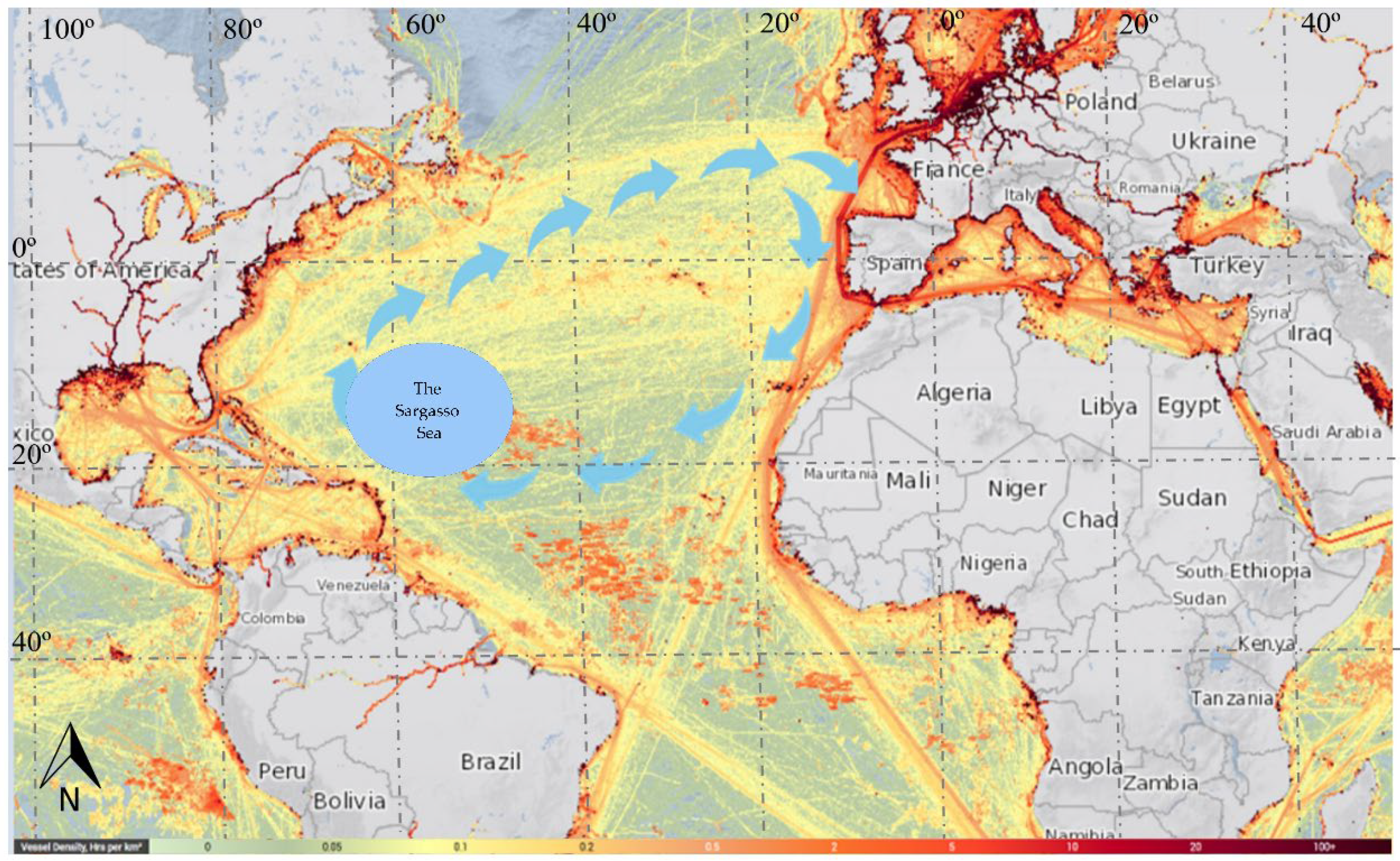
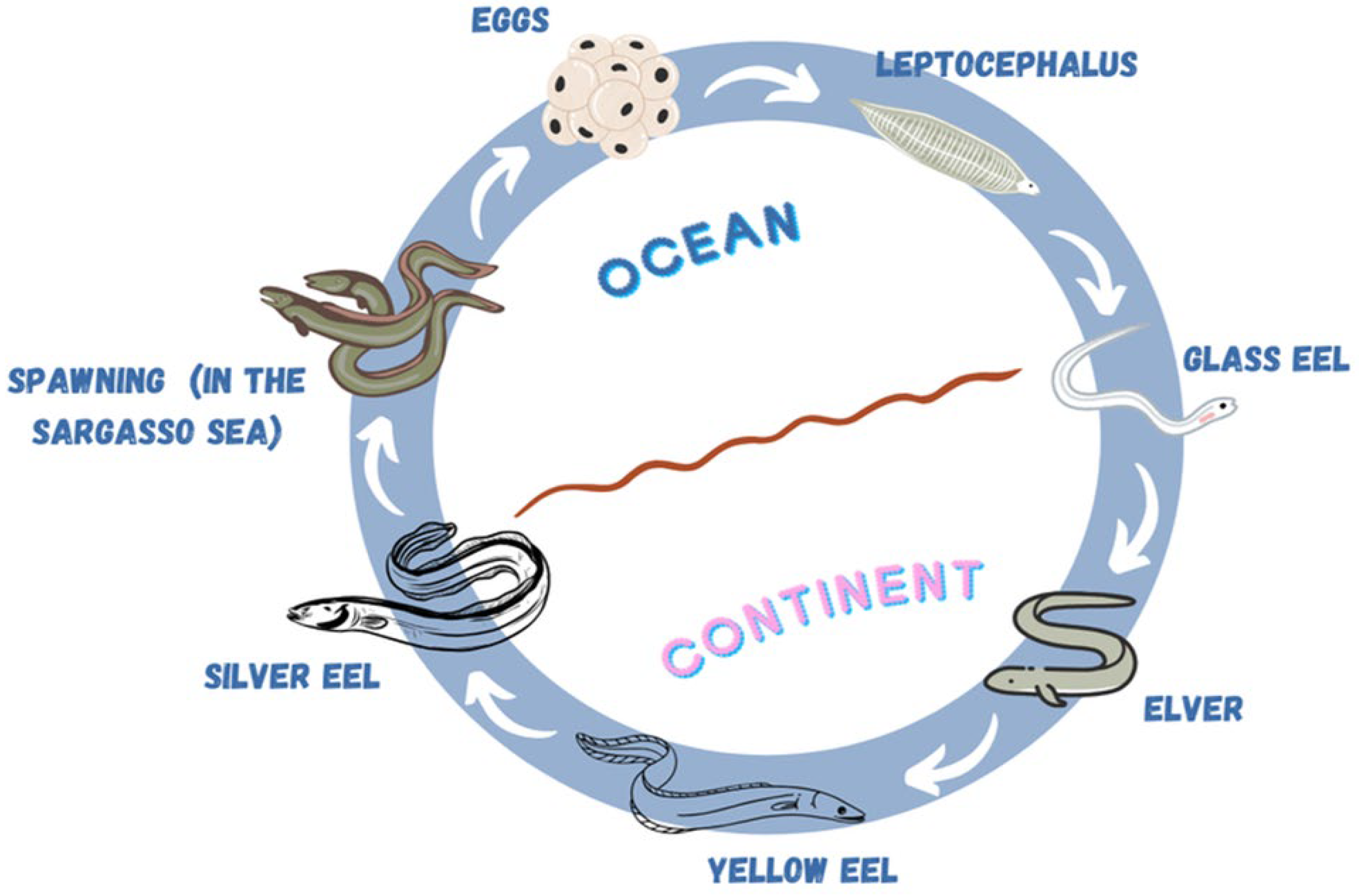
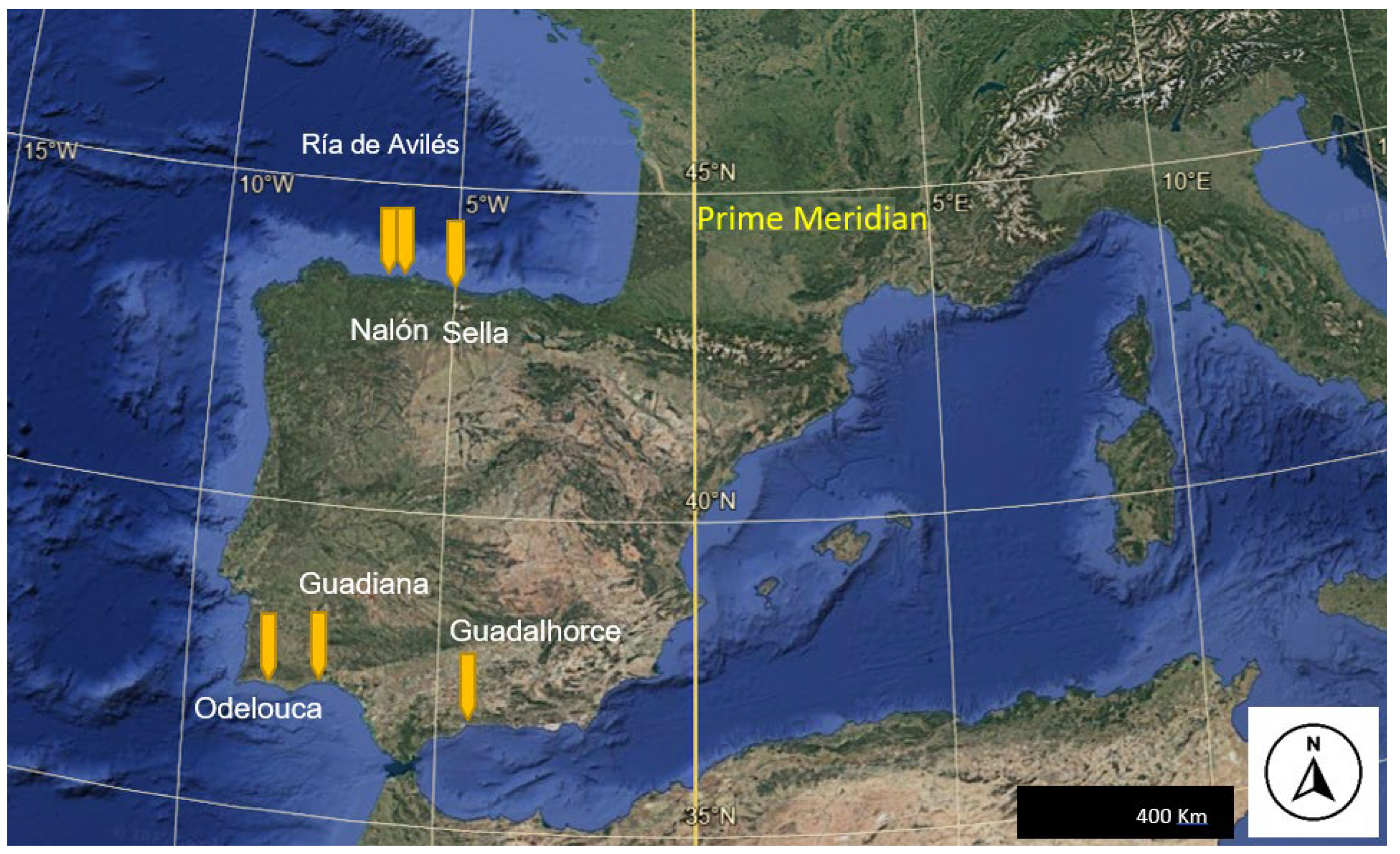
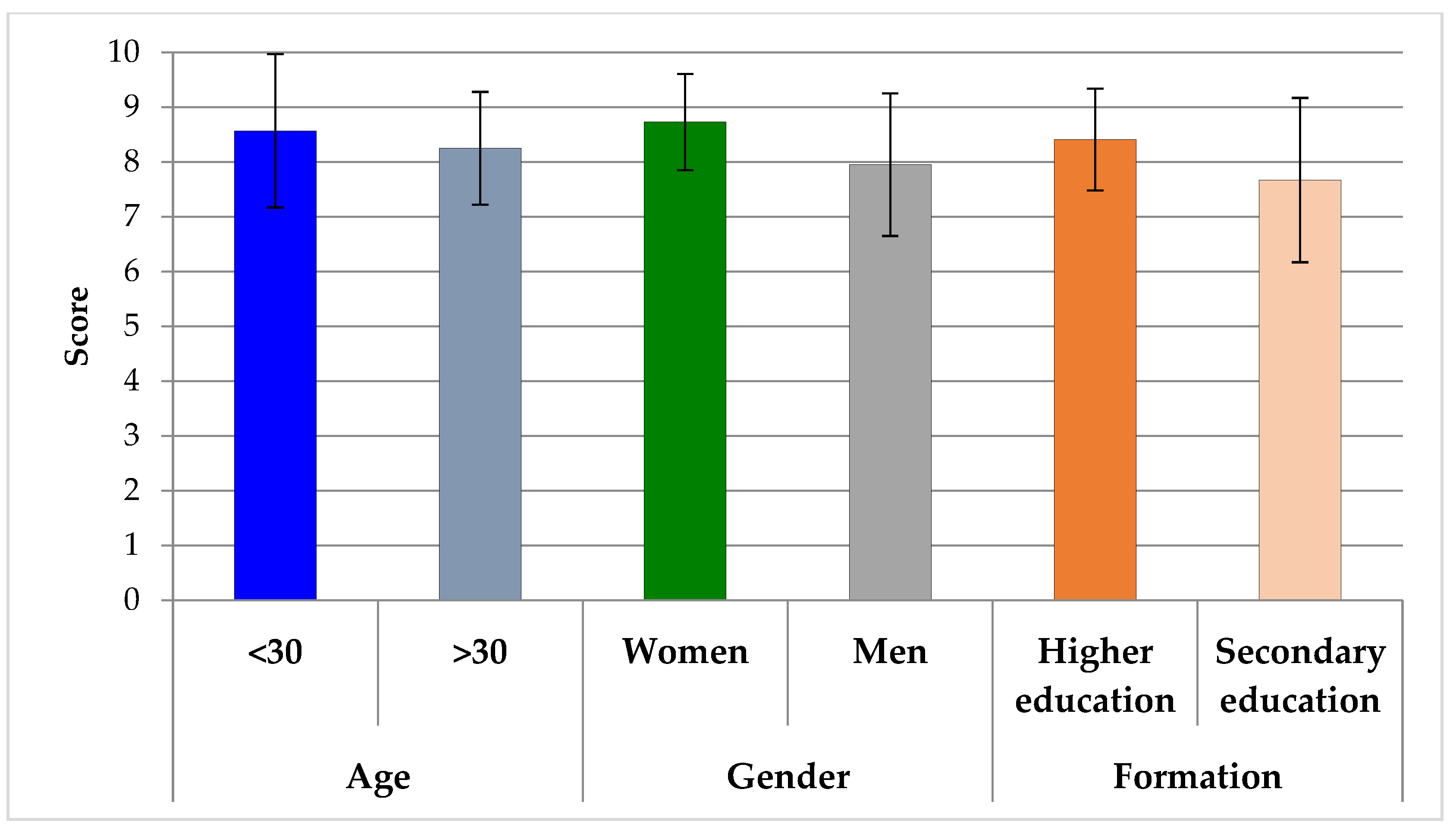
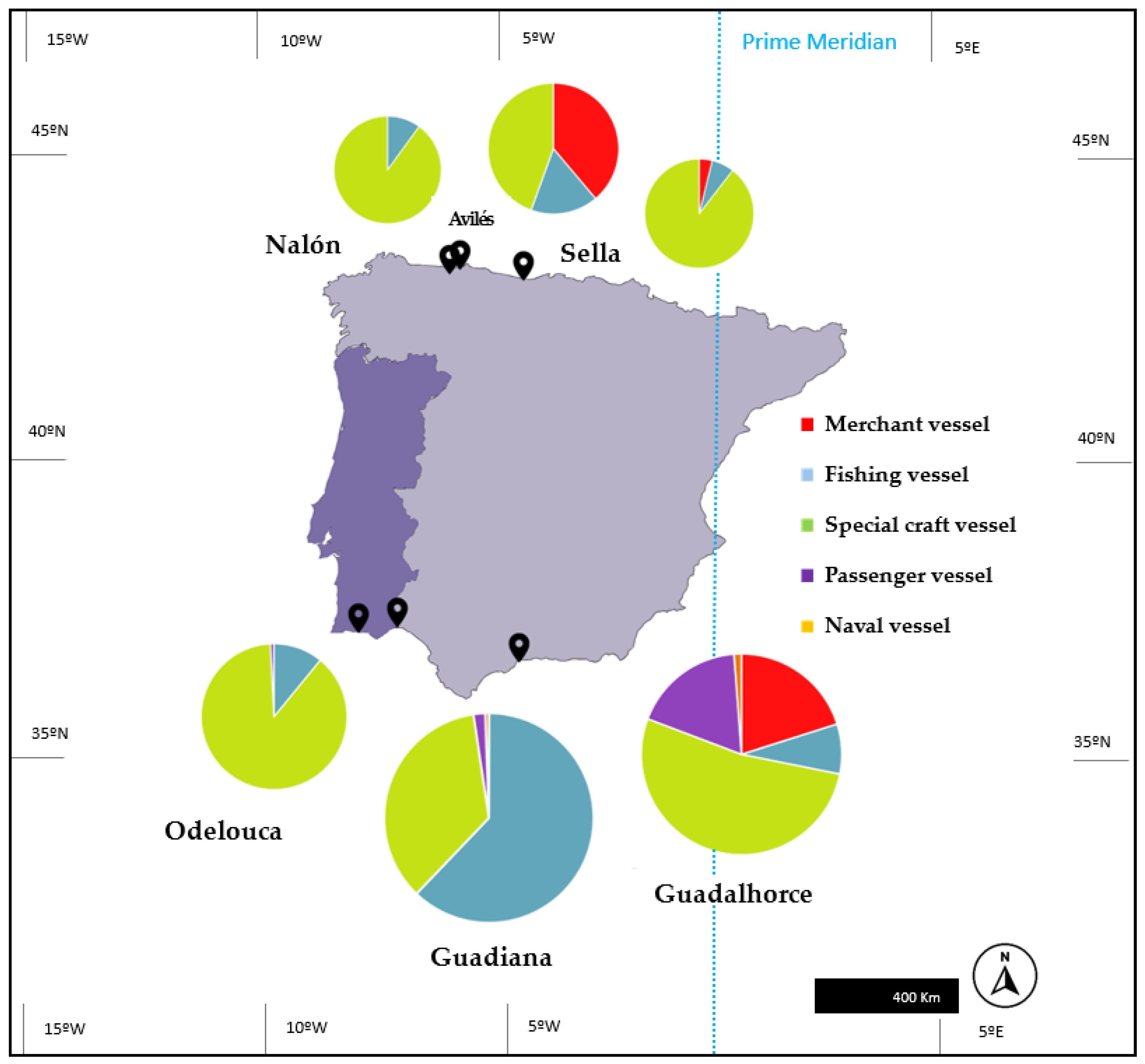
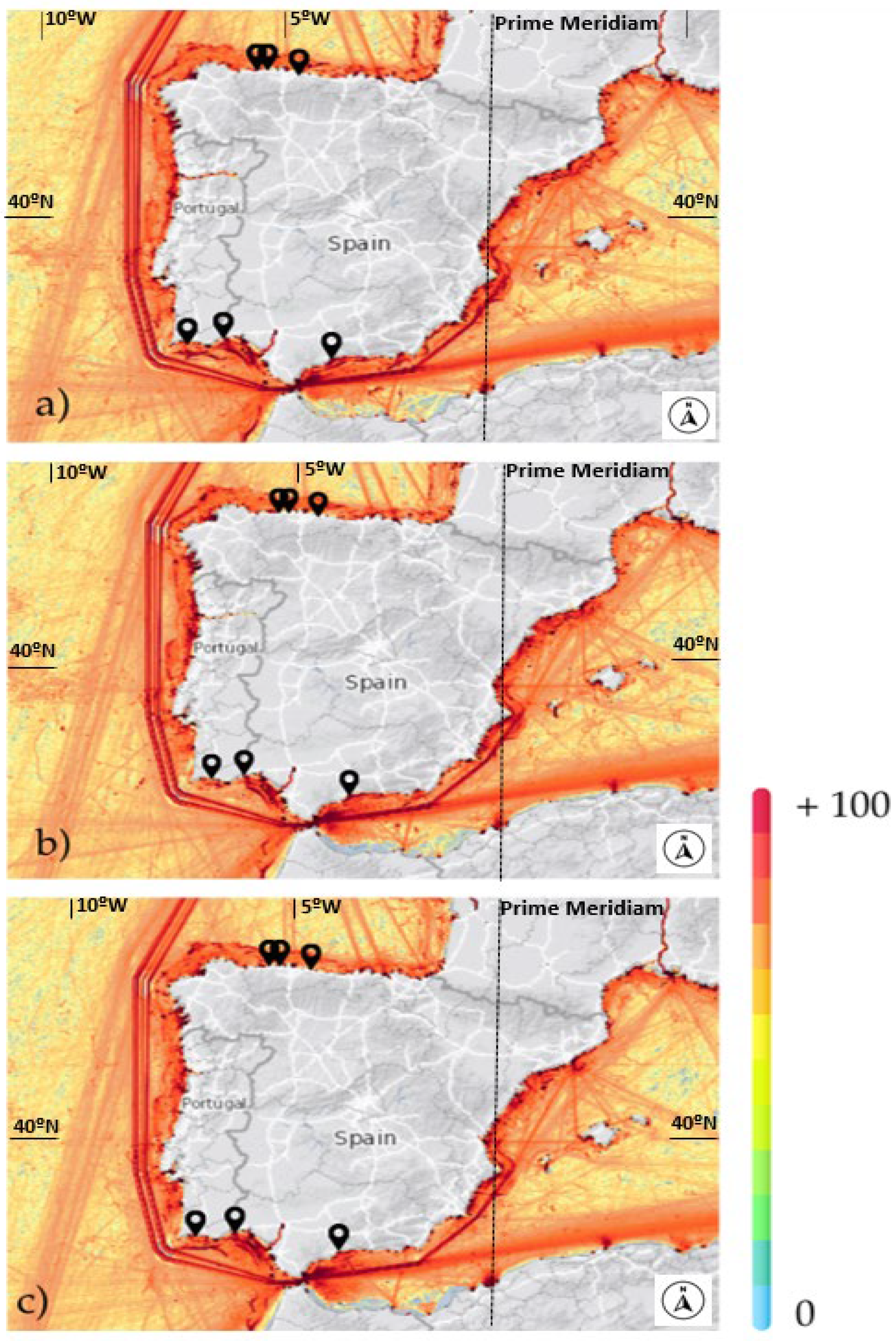
| Estuary | Coordinates | River Length (km) | Number and Type of Ports |
|---|---|---|---|
| Nalón | 43°33′53″ N 006°04′36″ W | 140.8 | Two fishing ports |
| Sella | 43°28′02″ N 005°03′51″ W | 66 | A fishing port and a marina |
| Ria of Avilés | 43°35′34″ N 005°56′08″ W | 22.1 | A fishing port and a marina |
| Odelouca | 37°10′38″ N 008°29′07″ W | 92.5 | A marina |
| Guadiana | 39°07′54″ N 003°43′59″ W | 865 | Two fishing ports and three marina ports |
| Guadalhorce | 36°39′58″ N 004°27′18″ W | 154 | A fishing, commercial, and marina port |
| Nomenclature | Vessel Type |
|---|---|
| Bull carrier; Oil/Chemical tanker; Container; Crude oil tanker; LPG tanker; Ro-Ro/Passenger ship; General cargo; Cargo vessel; Chemical vessel; Container cargo; Container ship; Container vessel; Vehicles carrier | MEs (Merchant vessels) |
| Trawler; Fishing; Fishing vessel | FIs (Fishing vessels) |
| Special craft; Sailing vessel; Recreational craft; Yacht; Firefighting vessel; SAR | SCs (Special Craft vessels) |
| Passenger | PAs (Passenger vessels) |
| Naval craft; Maritime ops | NCs (Naval vessels) |
| Iberian Coast | Type of Vessel | |
|---|---|---|
| South | North | |
| 0.054 | 0.255 | Cargo |
| 0.304 | 0.136 | Fishing boat |
| 0.579 | 0.609 | Special craft + sailing + recreational |
| 0.058 | 0 | Passenger vessel |
| 0.006 | 0 | Naval craft |
| 11,256 | 3962 | N |
| Andalusia | Asturias | |
|---|---|---|
| Wetland area, pristine (ha) | 186,757.0 | 2306.6 |
| Wetland area, current (ha) | 61,335.0 | 1635.1 |
| Pristine escapement (kg) | 3,735,140 | 46,132.2 |
| Current escapement (kg) | 626,150 | 16,513.3 |
| Current/pristine escapement (%) | 16.8% | 35.8% |
Disclaimer/Publisher’s Note: The statements, opinions and data contained in all publications are solely those of the individual author(s) and contributor(s) and not of MDPI and/or the editor(s). MDPI and/or the editor(s) disclaim responsibility for any injury to people or property resulting from any ideas, methods, instructions or products referred to in the content. |
© 2025 by the authors. Licensee MDPI, Basel, Switzerland. This article is an open access article distributed under the terms and conditions of the Creative Commons Attribution (CC BY) license (https://creativecommons.org/licenses/by/4.0/).
Share and Cite
Rivas-Iglesias, L.; Garcia-Vazquez, E.; Soto-López, V.; Dopico, E. Citizen Science on Maritime Traffic: Implications for European Eel Conservation. Oceans 2025, 6, 50. https://doi.org/10.3390/oceans6030050
Rivas-Iglesias L, Garcia-Vazquez E, Soto-López V, Dopico E. Citizen Science on Maritime Traffic: Implications for European Eel Conservation. Oceans. 2025; 6(3):50. https://doi.org/10.3390/oceans6030050
Chicago/Turabian StyleRivas-Iglesias, Lucía, Eva Garcia-Vazquez, Verónica Soto-López, and Eduardo Dopico. 2025. "Citizen Science on Maritime Traffic: Implications for European Eel Conservation" Oceans 6, no. 3: 50. https://doi.org/10.3390/oceans6030050
APA StyleRivas-Iglesias, L., Garcia-Vazquez, E., Soto-López, V., & Dopico, E. (2025). Citizen Science on Maritime Traffic: Implications for European Eel Conservation. Oceans, 6(3), 50. https://doi.org/10.3390/oceans6030050






